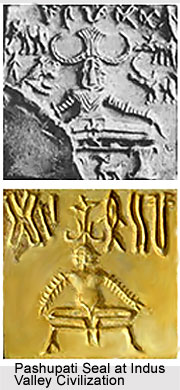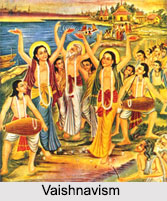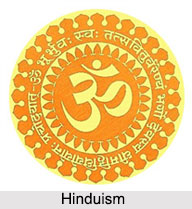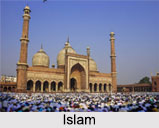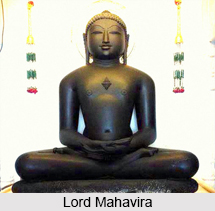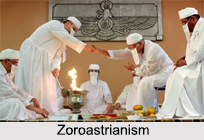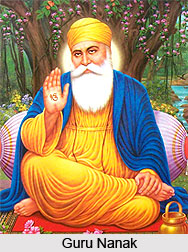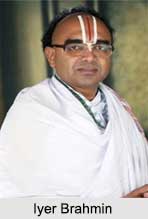Introduction
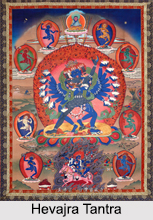 Hevajra Tantra stands out as a specimen of Vajrayanic theory and praxis from among the vast volume of Tantric Literature. It is also considered to be one of the most prominent Yogini Tantra belonging to the Anuttarayogo class of Buddhist tantras. It was one of the chief tantric cycles introduced in the later part of the 10th century A.D.
Hevajra Tantra stands out as a specimen of Vajrayanic theory and praxis from among the vast volume of Tantric Literature. It is also considered to be one of the most prominent Yogini Tantra belonging to the Anuttarayogo class of Buddhist tantras. It was one of the chief tantric cycles introduced in the later part of the 10th century A.D.
Etymology of Hevajra Tantra
"Hevajra" is composed of two syllables: "he" signifying Karuna or compassion and "vajra" signifying Prajna or wisdom. Thus the term "Hevajra" indicates the ultimate reality, which is the fusion of Sunyata and Karuna. The title also indicates the method that this tantra employs to attain its goal, which is one of Wisdom and Means. Muktavali states that Mahakaruna, with Sarvadharma Sunyata as its content, is Hevajra.
Concepts In Hevajra Tantra
Concepts in Hevajra Tantra are not too clearly defined in the text. Theoretical notions and practical guidelines lie scattered throughout the text. In order to get a better comprehension of the same, it is essential to categorize and delve deeper into the various principles and themes of Hevajra Tantra. There is to be found a clear network of ideas existing within the work once the various concepts have been systematically set apart, expounded and studied. An analysis of the text reveals that the basic theoretical foundations and premise of the text are Mahayanic. Hevajra Tantra itself is a work written in the later states of development of Mahayana Buddhism, more precisely Vajrayana school of Buddhism. Thus the entire premise itself is based on Mahayanic principles and understanding, with a more refined outlook. The core concepts of Madhyamika and Yogacara lie scattered throughout the text. These have been collectively referred to as the `Mahayana Foundations.
The prime concepts underlying the theory and practice of Hevajra Tantra are identified below.
Absolute as Tathata
Situated at the core of the philosophical foundations of tantra is the Madhyamika institution of Tathata. It asserts the fundamental unity of nirvana and samsara, of mystical and sensual experiences, and it regards all means as relative to the needs of the practiser. The entire process is kept in check by the conservative tendencies of the Yogacaras, and therefore, the whole movement remains essentially Buddhist. According to the Madhyamika, the Real is one, uniform, undifferentiated nature. It is transcendent to thought as non-relative, non-determinate, non-discursive, non-dual and quiescent. It is referred to in many ways- as tathata, bhutakoti, dharmata, dharmadhatu and sunyata.
Tathata is the ultimate experience in which the real and the intuition of it are non-different (advaya). Tathata does not believe in differentiation and degrees, nor is it the result of the accumulation of Knowledge. Tathata is achieved through the purification of the intellect, which in turn arouses the intuition (prajna).
The Vajrayanic equivalent of tathata is vajra. Bhagavan equates sunyata with Vajra in the Yogaratnamala when he says that the void, sunyata, which is the firm essence- indestructible, indepletable, indivisible, and which could not be consumed- is called vajra.
The same Madhyamika insight is also found reverberated in the Hevajra Tantra. The first verse in chapter five says that the Real is devoid of constructive imagination (sarvakalpanak-sayarupam) and it is non-dual (advaya). It states that there is no duality in the real (grahya-grahakabhava). The Hevajra Tantra is in perfect agreement with the Yogacara view as well, that the absolute is a non-dual consciousness and that the subject-object duality does not pertain to it. "By their very nature, there is neither form nor the one who sees neither sound nor listener, neither smell nor the one who smells neither taste nor the one who tastes neither touch nor the one who touches and there is neither mind nor thought." It is believed that in terms of the True Principle, tattva, smell, sound, form, mind etc. do not exist. Everything such as, the six senses, the Aggregate of the Five Components of Phenomenal Awareness, mantra, deity, is an aspect of the undifferentiated nature, or `thusness` (tathata). It is due to ignorance that things, which are essentially non-existent, appear as though they actually exist outside one`s consciousness. Due to ignorance again, all things appear to be in bondage, but in truth all things are `released`.
These passages of the text echo the ultimate identity of nirvana and samsara as taught by the Madhyamika. The text upholds the unique Vajrayanic insight that the Real is Innate (sahaja) and is of the nature of Great Bliss (mahasukha).
Absolute as Tathagata
Tathata and Tathagata are concerned as two intertwined entities. If the former is considered as prajna or sunyata, the latter may be considered as characterised by the principles of both sunyata and karuna (compassion). Tathatd is the impersonal Absolute, while Tathagata is the principle of mediation between the absolute and the phenomenal. All absolute systems require a mediator, and that need is fulfilled by Isvara in Vedanta philosophy and the Tathagata in Madhyamika and Yogacara vijnanavada. It is believed that only someone who enjoys a sort of dual status, with one foot in the phenomena and the other in the absolute can possibly know the truth and reveal it to others. This serves as the basis for the concept of Tathagata which is complicated metaphysically, but a theological necessity nonetheless. This dual nature of the tathagata, as one with the Absolute and yet actively pursuing the welfare of all beings, serves as the philosophical basis for the theological concept of the trikaya of the Lord Buddha, namely the dharmakaya, the sambhogakaya and the nirmanakaya.
This duality of the Madhyamika institution of Tathagata is found re-iterated in the Hevajra Tantra. It states that, "The Auspicious One enters into the Thusness (tathata) and similarly returns (agata). By this kind of wise reasoning he is known as Tathagatha."
In the text, Tathagata is called Bhagavan, Vajradhara, or the Auspicious One. Bhagavan refers to Vajradhara in the form of Hevajra. He is endowed with bhaga, that is, the six qualities of lordliness, abundance, grace, excellence, splendour and meaningful application of knowledge. The text adopts the three kayas as expounded by the Mahayana tradition and associates them with the various chakras of the tantric subtle body. In addition to the three kayas envisaged by Mahayana, Vajrayana has incorporated a fourth kaya called the mahasukhakaya (the body of Bliss). The fourth kaya is the fusion of the above three kayas, which is the state of the Tathagata (Hevajra) and it is realised through the complex Hevajra sadhana.
Concept of Tathagatagarbha
At the root of all tantric sadhana lies the mahayanic concept of tathatgatagarbha. All beings contain within themselves the seed of enlightenment and are potential Tathagatas (tathagatagarbha). It has been stated in the Madhyamikakarika that nirvana is not something that can be achieved through abandonment or achievement. It is in fact the eternal status of all sentient beings. Mahayana believes that all beings are already Buddhas. This conviction is reaffirmed by the Hevajra Tantra. It states that, "There exists no one being who is unenlightened from the awakening to his own nature. By their very intrinsic nature, the beings in hell, ghosts, animals, gods, titans, men and even worms and so on in the dung, are eternally blissful, for they do not merely experience the pleasure of the gods and the titans". However, the sentient beings do not experience the enlightened state due to the jneyavaranas and klesavaranas. Therefore, the goal of Hevajra Tantra is not to produce enlightenment (bodhi). It is intended to enable the sadhaka to realise that he is essentially of the nature of bliss as he is already enlightened.
Concept of Avidya
Avidya, according to Mahayana, is the prime reason that prevents man from realising his enlightened nature. For the Madhaymika, avidya leads to constructive imagination (kalpana or vikalpa). The main causative factor of Samsara is engaging in views (drsti) and holding on to them. This leads to attachment and aversion, all of which leads to suffering. Avidya for the Yogacarin is the objectification of consciousness (visaya drsti) and the creation of subject-object duality (grahya-grahaka). "The Absolute consciousness is non-dual, but when infected by the illusory idea of the `other`, it is diversified into the subject and object. The function of avidya is the creation of this fundamental duality."
In the Hevajra Tantra are found terms like ajnanam and aguntakamala in order to refer to the obscurations that hide the enlightened nature of things. It is said in the hevajra tantra, "Truly all beings are enlightened beings but they are veiled by the accumulation of defilements. By removing this veil of defilements, all beings are enlightened beings without doubt". These defilements or avidya are said to consist of two avarnas- jneyavarana and klesavarana. Jneyavarana includes such drstis or vikalpas as thoughts of worthiness and unworthiness (bhagabhagavicara), likes and dislikes (istanistvikalpa) etc. It has been said that men are deluded by not knowing the real (loko muhyati vetti na tattvam). Bhagavan in the text adopts the yogacara view that defilements are due to the existence of subject-object duality (grahyagrahakabhavat). Incorrect and wrong views generate afflictions (klesavarna). It is by the purification of these defilements that thusness is realised and attained.
Concept of Bodhichitta
Bodhichittotpada is the name given to the disciple who is undertaken to attain bodhi (Enlightenment). The principal features of the bodhichitta are sunyata and karuna. Sunyata is prajna, intellectual intuition, and is identical with the absolute. The active principle of compassion is the karuna. It gives concrete expression to the sunyata in phenomena. Thus bodhicitta is a unique blend of intellect and will; it becomes the foundation of all altruism.
The Mahayanic tradition preaches the realisation of bodhi through the practice of the Six Paramitas and the Ten Bhumis. In Vajrayana, bodhichitta is seen as comprising two aspects- the absolute and the relative. From the aspect of the absolute, it is understood to be the supreme mystical experience, and as such may be called mahasukha, which is self-experienced (svasariwedya) and sahaja (innate). As relative, it is equated with life-force, the essence of samsara. This again has two forms- the female coefficient and the male coefficient.
There are a total of three nadis in the tantric conception of the subtle body, namely the lalana, rasana and avadhuti. In the tantric conception of the subtle body, there are three important nadis, namely lalana, rasana and avadhuti. At the base of the generative organ where lalana and rasana unite and avadhuti ascends, bodhichitta exists in its relative form (sukra). At the crown of the head bodhicitta exists in its absolute condition as mahasukha, known also as the Moon. Prajna or Sunyata is the female and the male is the upaya or the karuna. Bodhichitta in its relative aspect is achieved through the union of the yogi with the yogini. This limited experience strengthens the resolve of the practitioner and gives him a foretaste of the ultimate enlightened consciousness. It is believed that yogic practices enable the sadhaka to retain the relative bodhichitta at the nirmana cakra and force it upward through the avadhuti to ultimately unite with the bodhichitta residing at the usnisakamala or mahasukha cakra, the highest cakra. This union is spoken of as the union of the lady with the lord and is of the nature of great bliss. This union can also be achieved through a process of inner union of the two nadis in meditation according to the guru`s instructions.
Nature of Nirvana
Nirvana is considered as something almost inexpressible by the different schools of Buddhism. It is not something that can be physically attained. The transformation that takes place is not so much ontological (objective) as it is epistemic (subjective). So what actually undergoes a transformation in the entire process is the attitude of the seeker. According to the Madhyamika, the nature of nirvana is indeterminate (asamskrta). The Yogacarin considers the state of nirvana to be the state of consciousness which is rid of subject-object duality and rests in itself. This nirvana is of the nature of supreme bliss (mahasukha).
Nirvana is not a separate reality or a different state from that of saimdra. It is said that the absolute is the only real. It is nothing but phenomena (samsara) viewed without the distorting medium of constructive imagination.
A number of different terms have been employed by the hevajra tantra in order to signify nirvana- siddhi, sahaja, mahasukha, mahamudra etc. For the Vajrayanist, the accomplishment of the Mahamudra is without distinction (adbhedyalaksana) and unachieved (asiddha). It is, as also viewed by the Yogacarin, where consciousness rests in itself and does not create. It is a state of supreme delight. Throughout the Hevajra Tantra, this aspect of the bliss of nirvana has been highlighted.
Features of Hevajra Tantra
The significance of Hevajra Tantra is immense. It has led to a synthesis of the essence of Buddhist speculation with tantric theory and praxis. The Hevajra Tantra recommends a gradual and progressive assimilation of Buddhist teachings, culminating in the Hevajra Sadhna. The text of the Hevajra Tantra has fused and synthesised the Sila, Samadhi and prajna of early Buddhism with the basics of Mahayana speculation with both insights as well as practice. It states that the disciples are to be first given an injunction for their conduct, and then instructed upon their fundamental moral precepts. Then they are to be instructed on Vaibhasya doctrine and after that the Sutranta doctrine. Following this are the Yogacara doctrine and then the Madhyamika doctrine. After all this is done, the instructions on the practice of the Hevajra doctrine are commenced. By way of this unique synthesis, the text occupies a significant place in Buddhist literature in general.
The text of the Hevajra Tantra, being a specimen of Vajrayanic literature, is a unique testament to the theory and praxis of tantric Buddhism. It sheds much light on the tantric period of Indian religious history. Previous tantric works, as found in the Guhyasamaja, Manjusrimulaklapa and the Sarvatathagatatattvasamgraha have been given a systematic form and elaborated on in the text of the Hevajra Tantra.
Apart from shedding light on past works, the work has also exercised great influence on succeeding tantra in Buddhism and tantric literature in general. The Hevajra Tantra is the most quoted text in the Sanskrit commentaries on Vajrayanic texts. The Advayavajrasamgraha, Sekoddesatika and others borrow liberally from this text. Verses from the text are found also in the Tantric Buddhist songs in old Bengali as well as in Dohas written in Apabhramsa.
In the matter of magical rites and rituals, generation of yoginis and manifestation of deities, the text claims technical proficiency. The greatness of the Hevajra sadhana is borne by the text itself. The text itself states that nothing can be accomplished without the knowledge of the Hevajra Tantra. It states,
`There is no accomplishment attained by following all the Vedas, Siddhantas and traditions of ritual. By following their purifications, there is rebirth in another cycle of existence. Without this knowledge (of Hevajra Tantra) there is no accomplishment possible in this or any other world. The effort of the one who does not know Hevajra is all in vain.`
The Hevajra Tantra is one of the most renowned of Buddhist tantras held in high esteem in Tibet by the Ka-gyu-pas and the Sa-kya-pas. For them it is a fundamental treatise, and the subject of much exegetical enterprise.
A number of famous acharyas and their disciples are also known to have held the Hevajra in high esteem. Maitrpa (also known as Advayavajra) is known to have had a special predilection for this tantra. It was this rite into which the great Kublai Khan of the Mongols was initiated. The yearning of Milarepa to join the congregation, to which his Guru Marpa, the Translator, is supposed to be preaching the Hevajra Tantra, shows the great esteem it enjoyed among acharyas and their disciples.
Thus, it may be said that the Hevajra Tantra occupies a highly respected position in the Vajrayanic literature. It is esteemed as a unique treatise of tantric theory and praxis. Its peerless position is due to the fact that it has been able to synthesis the inspirations of early Buddhism, later Mahayanic speculations, and tantric insights and praxis.
In fact it has been seen that the deities of the Hevajra Mandala are actually nothing else but the dharmas enumerated by the early Theravada school of Buddhism and Sautrantika school of thought. The practice of virtues that these schools upheld is presupposed in the Hevajra Tantra. The Hevajra tantra is a precise and enlightening compilation of various tantric insights and practices that are common to the Vajrayana school of Buddhism in general. Thus the Hevajra Tantra is highly revered as a masterpiece of Vajrayanic literature.
Literary Style and Language of Hevajra Tantra
 Literary style and language of Hevajra Tantra presents a fine example of tantric language and compositional style. The language is inferior Sanskrit with tinges of the vernacular as well. There is a couplet in the Apabhramsa dialect describing the characteristic of the Innate. Other passage in the vernacular can be found elsewhere in the text. The use of the vernacular as against the Sanskrit literary tradition of orthodox Brahmins is in tune with the spirit of rebellion championed by the medieval poets of Northern India. Defects of language that plague all tantras are found in this tantra as well. Grammatical errors are numerous and the text shows utter disregard for scansion.
Literary style and language of Hevajra Tantra presents a fine example of tantric language and compositional style. The language is inferior Sanskrit with tinges of the vernacular as well. There is a couplet in the Apabhramsa dialect describing the characteristic of the Innate. Other passage in the vernacular can be found elsewhere in the text. The use of the vernacular as against the Sanskrit literary tradition of orthodox Brahmins is in tune with the spirit of rebellion championed by the medieval poets of Northern India. Defects of language that plague all tantras are found in this tantra as well. Grammatical errors are numerous and the text shows utter disregard for scansion.
The Hevajra Tantra opens like a sutra. The literary style of both the sutras and the tantras are similar. They exist in the form of dialogues delivered by the Lord Buddha to congregations of disciples, bodhisattvas, or divinities in various heavens. The Buddha`s answers to the questions raised by the congregation often astound his hearers and they drop down senseless. These pronouncements are often disorderly, stated authoritatively without any attempt to demonstrate their veracity. There are sudden interruptions and long digressions. The text exhibits a crude and disjointed style, and logical construction is conspicuous by its absence. The Yogaratnamala is written in the panjika style. This is a type of commercial style where words or phrases from successive units of the root treatise are taken and commented on.
Like other tantra in Buddhism the Hevajra Tantra begins with the nidanavakyam, the fundamental statement - `evam maya srutam`. This fundamental statement embodies within itself, in a cryptic manner, the upaya (the mode of practice), and the ultimate experience. There is frequent employment of sandhyabhasa, which shields the true meaning of the text from the uninitiated and renders it an esoteric aura. From a practical point of view, it enables the writer to economise on the repetition of details regarding concepts and practices found within the treatise. Complex notions have been compressed into certain key names, words, or phrases. The text employs a picturesque language, rich in symbolism and graphic in details.
Theories of Hevajra Tantra
The theories of Hevajra Tantra reveal the influence of the Mahayanic philosophical tradition inherent in the theories. A thematic analysis of the Hevajra tantra reveals the presence of certain insights which are specifically tantric in nature. Therefore, this gives credence to the view that tantric theory is a combination of the philosophical traditions of Mahayana Buddhism as well as certain tantric assumptions. The prime theoretical beliefs are discussed below.
Bi-polar Nature of the Non-dual Reality
 One of the most basic premises of the Hevajra Tantra is the in-built and inseparable bipolarity within the non-dual Absolute. The tantric vision of the Absolute is that it is a conjunctio oppositorum. The bi-polarity of the absolute is expressed as positive-negative, active-passive, male-female etc. In order to signify this polarity, the Hevajra tantra uses certain complex compound nouns such as prajna-upaya, sunyata-karuna, lalana-rasana, ali-kali etc. The name Hevajra itself signifies the inherent polarity of the non-dual absolute. Hevajra is Vajradhara. It has been asserted in the Yogaratnamala that Vajradhara is the Supreme Non-duality (vajradharabhattarakaw paramadaivatam). The name Hevajra has been explained in the text of the Hevajra tantra. It is said to be composed of two syllables, `he` signifying mahakaruna, and `vajra` meaning prajna. Karuna is also called upaya (kipopaya) and the polarity is also expressed as prajnopaya (wisdom and means). Prajna and upaya are associated with the two nadis lalana and rasana. Again, prajna and upaya are related to the vowel (ali) and consonant (kali). The text also employs other names like Candali and Vajrasattva, which imply the bi-polar nature of the Absolute. Thus the concept of the bi-polar nature of non-dual reality is extensively mentioned and elucidated throughout the text, and forms one of the basic theoretical assumptions of the Hevajra Tantra.
One of the most basic premises of the Hevajra Tantra is the in-built and inseparable bipolarity within the non-dual Absolute. The tantric vision of the Absolute is that it is a conjunctio oppositorum. The bi-polarity of the absolute is expressed as positive-negative, active-passive, male-female etc. In order to signify this polarity, the Hevajra tantra uses certain complex compound nouns such as prajna-upaya, sunyata-karuna, lalana-rasana, ali-kali etc. The name Hevajra itself signifies the inherent polarity of the non-dual absolute. Hevajra is Vajradhara. It has been asserted in the Yogaratnamala that Vajradhara is the Supreme Non-duality (vajradharabhattarakaw paramadaivatam). The name Hevajra has been explained in the text of the Hevajra tantra. It is said to be composed of two syllables, `he` signifying mahakaruna, and `vajra` meaning prajna. Karuna is also called upaya (kipopaya) and the polarity is also expressed as prajnopaya (wisdom and means). Prajna and upaya are associated with the two nadis lalana and rasana. Again, prajna and upaya are related to the vowel (ali) and consonant (kali). The text also employs other names like Candali and Vajrasattva, which imply the bi-polar nature of the Absolute. Thus the concept of the bi-polar nature of non-dual reality is extensively mentioned and elucidated throughout the text, and forms one of the basic theoretical assumptions of the Hevajra Tantra.
The Absolute as Union of Polarities
The Absolute is represented as the unity of polarities (yuganaddha) in the Vajrayana school of Buddhism. Iconographically, this is portrayed in the union of the Hevajra and Nairatyma. Sunyata is represented by the Nairatmya whereas Hevajra embodies karuna. Bodhichitta, according to the text, is the mingling of the sunyata and karuna. However there is no distinction in the Absolute. It is non-dual (advaya) and devoid of all constructive imagination (sarvasamkalpavarjita) and subject-object duality (grahya-grahaka varjita). There is no distinction in the absolute such as prajna-upaya or sunyata-karuna. It is characterised as Innate Joy (sahajanandam) or Great Bliss (mahasukha). This great bliss is inexpressible and has to be experienced within one`s own body (svasamivedyam mahat sukhairif). As said in the text, "By the complete awakening of the True Principle there is neither Wisdom nor Means."
The Body as the Sphere of Realisation
The theory about the body seen as the sphere of realisation brings about a certain difference between the Mahayana and Vajrayana tradition. Whereas the Mahayana tradition gives importance to the intellect and finally to Intuition in the realisation of the Absolute, Vajrayana highlights the role of the body within which alone the Absolute is experienced as bliss (dehabhave kutah saukhyam). It is stated in the text that truth resides within the body (dehastham ca mahajnanam). The process toward the realisation of the absolute as bliss involves several bodily practices (kaya sadhana). Both the entire gross body as well as subtle body constituted of nadis and chakras are involved in the practice of Vajrayana.
Body as the Microcosm
Vajrayanic beliefs hold the human body as the microcosm. Each and every aspect of the universe is identified with the various parts of the gross or subtle body. The elements that constitute the world are related to the four chakras. The five skandhas which form the universe are reduced to three, namely the Body, Speech and Mind and these are related to the three nadis lalana, rasana and avadhuti. The pithas are located within the body. The body is said to be the nikaya (assembly of bhikshus), and the womb is the monastery (vihdra). The three kayas of the Tathagata are located in the chakras of the subtle body. Thus, the body is conceived as a microcosm, which houses every aspect of the cosmos, the macrocosm.
Homologous Vision of Existence
Homologous means having a pattern or correspondence. From the point of view of the Vajrayana, all aspects of existence correspond with everything else. The entire text is seen involved in finding a series of such correspondences. Thus there are seen three-fold, four-fold, five-fold and sometimes six-fold `co-respondences`. Distinctions and divisions found in saitrvrti can be overcome by viewing everything as `co-responding`. The yogi is trained to see all things as related and finally to realise that all distinctions as well as relations are false.
Non-Duality in Hevajra Tantra
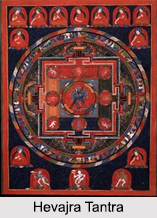 Non-Duality in Hevajra Tantra consists in the polarity of the absolute between the active and the passive, the positive and the negative. A number of tantric theoretical assumptions have contributed to the formation of the Vajrayanic theory and subsequently of the Hevajra Tantra. It has inherited from the beliefs of Mahayana Buddhism. In Vajrayanic belief, the most vital concept seen is of the Absolute as being bipolar in nature. In Mahayanic beliefs, it is considered as constituting the two polarities within the Absolute, and these two polarities are viewed as female and male.
Non-Duality in Hevajra Tantra consists in the polarity of the absolute between the active and the passive, the positive and the negative. A number of tantric theoretical assumptions have contributed to the formation of the Vajrayanic theory and subsequently of the Hevajra Tantra. It has inherited from the beliefs of Mahayana Buddhism. In Vajrayanic belief, the most vital concept seen is of the Absolute as being bipolar in nature. In Mahayanic beliefs, it is considered as constituting the two polarities within the Absolute, and these two polarities are viewed as female and male.
Another very important perspective adopted herein is that the body is the microcosm and hence the abode of truth. The truth is realised within the body through direct personal experience known as "Swasarivedyam". The realization of the absolute, is believed, leads a person to have a "homologous vision" of the world. These are the primary principles that have influenced the tantric principles that constitute the Hevajra Tantra.
Nature of the Non-Duality in Tantrism
The most basic tantric principle of Hevajra Tantra is the non-dual nature of reality. Reality is seen as being bipolar. The fundamental principles of Tantra assert two main things in keeping with diametrical polarity:
i. Everything is "conjunctio oppositorum", and
ii. In everything there is a built-in polarity, which may be expressed in terms of positive-negative, potential-kinetic, thought-action, intelligence-emotion, male-female, etc.
It is perhaps this insight which led to the belief that ultimate reality is Bipolar. The Nature of Non-Duality according to various beliefs is discussed below:
Tantra in Hinduism and Tantra in Buddhism both assert that there are two aspects to ultimate non-duality: the positive (pravitti) and the negative (nivitti), the static and the dynamic. These two aspects are found in Hinduism in the form of Shakti and Shiva.
In Buddhism these are represented by Prajna and Upaya, also known as Sunyata and Karuna. These are the principles of passivity and activity respectively. The former is comprised of Dharmakaya, while the latter comprises the whole world, Sambhogakaya and Nirmdnakaya. These two are considered to be the manifestations of Karuna, as they are meant to lead all beings towards the ultimate goal. The relationship between the Prajna and the Karuna is such that they are different yet inseparable. This concept of the Ultimate Reality is a metaphysical necessity and not just a theological principle. The noumenon in Vajrayana, must have some principle of self diversification, and contain the germ of everything phenomenal. It must therefore be both passive and active.
The Mahayanic principles believe that phenomena are not something which is integral to Sunyata, but on the contrary something thrust on it from above. The bi-polarity is a tantric attempt to bridge the gulf between the Absolute and the relative (paramartha and samviti) - a unique way to accommodate the empirical.
In the Madhyamika, the bi-polar nature of the non-dual is foreshadowed by the conception of "Bodhichitta" as the mingling of the Sunyata and Karuna. This polarity is not understood in the tantric sense.
Thus the bi-polarity of non-dual reality is expressed in such compound terms as, Sunyata-Karuna, Prajna-Upaya, Lotus-Jewel, Ghanta-Vajra, Sun-Moon, Ali-Kali, Lalana-Rasana, Dinam-Naktam, etc.
Tantric Practices in Hevajra Tantra
Tantric practices, also referred to as Tantric means, refer to all those methods which lead the sadhaka to realisation. The tantric practices, despite being built on the theoretical framework of Mahayana Buddhism, are different from the way of the Paramitas as advocated by the Mahayanists. The practices or means prescribed by the Mahyanists comprise of the practice of the Six Paramitas and the Ten Bhumis. The Vajrayanists proposed a different set of means or practices for the generation of bodhichitta. The means suggested by the Hevajra Tantra are- Samvara (the concealed essence), Abhiseka (the Consecration), Sandhyabhasa (Tantric code language), ananda (Joys), Ksana (Moments), Carya (Applications of the vow) and Bhojana (Feast). These means or practices are collectively called the `Fundamentals of all Tantras.`
Samvara
The choicest of essences is the Samvara essences. It is called the `Concealed Essence` as it is concealed in the body. The understanding of Samvara is via two aspects- the absolute and relative aspects. In its absolute sense, it is the Innate Enlightened Consciousness. In the relative sense, it is the various concealed essences used in the tantric yoga method. At the basis of the concept of concealed essences are the male and the female procreative essence of our progenitors responsible for our psycho-physical existence. The innate is the fusion of the sunyata and karuna. It is a firm Vajrayanic belief that the union of the procreative essences permits the co-mingling of the sacred (the absolute unlimited enlightened consciousness) and the profane (the procreative essences) and enables it to co-exist until the dissolution of the body. Samvara essentially means bond or union. It indicates the union of all forms, of elements and of the two procreative coefficients- the male and the female. It signifies the union of the microcosm and the macrocosm.
Abhiseka
Abhiseka literally means `purification by sprinkling`. During the time of Manjusrimulakalpa and the Sarvatathagatatattvasamgraha, i.e., the earlier tantric period, it meant a rite of initiation by which the sadhaka was introduced to the mysticism and importance of the mandala. To be more precise, abhiseka translates into consecration. This consecration is four fold- the master (acarya), the secret (guhya), the Wisdom (prajna) and the Fourth (caturtham). The kind of consecration given to a disciple depends on his worthiness or disposition (sensibility). The kind of sensibility that is dominant divides the practitioners into three types - mild, medium and strong.
The Master Consecration is conferred on disciples of weak sensibility.1" It is conferred in order to make the candidate worthy to listen, reflect, and meditate upon the Hevajra and other Yogini tantras. The Secret Consecration is conferred on disciples of medium sensibility. The Wisdom Consecration is conferred on candidates of strong sensibility. The Fourth Consecration is experienced with an external consort, in accordance with the Guru`s instructions.
Sandhyabhasa
The word sandhi contained within the composite word means `the meaning agreed upon`. The word Sandhyabhasa therefore refers to that mode of communication which has an agreed prime intent. The words that belong to this class are to be treated as code language and should not be understood in their literal sense. When Sandhyabhasa is spoken in terms of means, it communicates various elements of tantric praxis. It is considered to be the great conventional mode of communication among the yoginis, which are not known to sravakas and others. They are not revealed in other tantras of Kriya, Carya, Yoga and Anuttarayoga. The yogi is enjoined to use the wonderful language of the Sandhyabhasam Mahabhutam to communicate with the followers of Hevajra Tantra, lest severe afflictions befall him.
Ananda
It is said in the Hevajra Tantra that the four stages of consecration impart one with the knowledge of the four joys. These joys are known as ananda. The four joys are- the Ordinary joy (ananda), the refined joy (paramananda), the joy of cessation (viramananda) and the innate joy (sahajananda). From the Ordinary joy there is some bliss; from the Refined joy there is even more; from the joy of Cessation there is the passionless joy; the joy of the Innate is considered the culmination of all joys. Yogaratnamala explains that the first three joys are of the phenomenal realm and they do not bring about release.
Regarding the relation between the first three joys and the innate joys, the Yogaratnamala states, "the absolute Innate Bliss is the cause of the relative bliss, the relative Bliss being a limited aspect of the absolute Innate Bliss. Therefore confidence is attained by means of the relative bliss which is limited aspect, similar in nature to the primary cause, the absolute innate Bliss."
The Yogaratnamala teaches that worldly joys are not to be spurned as they are the means which enable the achievement of the goal of the Great Bliss. The knowledge of the four joys is known in the four consecrations by marking the four ksanas, the four Moments.
Ksana
Ksanas are the various moments or stages in the process of realisation. These four stages or moments are: the Diverse (vicitra), the Ripening (vipaka) the Dissolving (vimarda) and the Signless (vilaksana). The Diverse moment is so called because it consists of a variety, embracing etc. The Ripening moment is the reverse of the Diverse moment. It is the enjoyment of the blissful knowledge. The Dissolving moment is said to be the moments of reflective thought, `I have experienced bliss`. The Signless moment is devoid of the phenomenal existence of the release. It is different from the other three in that it is free from passion and the absence of passion.
Carya
Carya means the application of the vows according to the instructions of the Guru and the Budhhas. Enlightenment is said to be quickly obtained by the Application of the Vow. This is given so that the stages of the consecration can be realised and stabilised. Different vows are prescribed for candidates of different sensibilities. For the disciple of mild sensibility the Differentiated Vow is prescribed. The candidate of medium sensibility is given the Undifferentiated Vow and to those of strong sensibility, the Extremely Undifferentiated Vow. The text does not mention any vow for those of the strongest sensibility. At their Fourth Consecration the application of the vow is realised through the Mahamudra.
Bhojana
Bhojana refers to the feast associated with the gathering of the circle of initiates. The feast is to be offered in a crematory, a mountain cave, deserted town or a lonely place. The seats are made of corpses or rags from the crematory or tiger-skins. The participants partake of the sacraments consisting of meat of cows, dogs, elephants, horses, and men. The disciple should give the Guru a skull-cup filled with liquor. It should be given with the left hand and received also with the left hand. `" This feast is considered the Differentiated Application of the Vow, which is aimed at making the sadhaka shed his conventional mind-set such as, worthy-unworthy, edible-inedible, etc.
These seven means listed above are therefore the means prescribed by the Hevajra Tantra in which lead a follower towards the goal of realisation.
